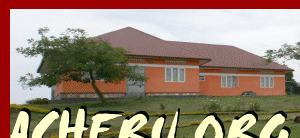| Circular - March 2022: Working with Cerebral Palsy at Acheru |
| The most common condition seen among Acheru outpatients is cerebral palsy (CP), and the Acheru staff have a lot of experience working with this. CP affects a person's ability to move and maintain balance and posture. It is the most common childhood motor disability. 'Cerebral' refers to the brain, 'palsy' means problems with using the muscles. |
| Symptoms vary widely with some children unable to walk or needing special equipment and possibly requiring lifelong care. Others aren't so severely affected, perhaps walking awkwardly but not needing special help. Although CP is not progressive, it may appear that way among children who have had no opportunity to develop. The perception may be that as a disabled child they have no potential, and they are ignored. They are 'worthless' and rejected whereas the reality may be that a lot can be done to help them. There is no cure for CP but treatment can dramatically improve quality of life and Acheru works not just with the child but with the whole family. |
| The picture below shows Pious, one of our first CP patients, with his father who was a community worker at our Minakulu unit, but as we've often found, he simply hadn't realised that Pious had any potential. Within a very short time Pious was walking unaided, and was soon able to start school. |
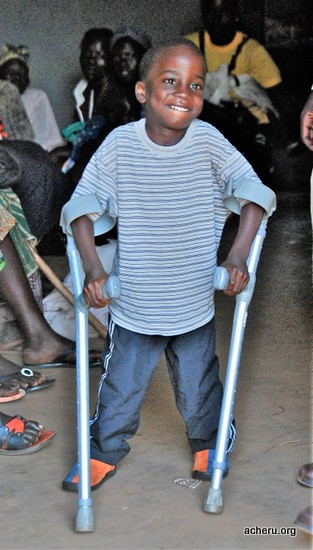 |
| Pious, one of our early CP patients who responded very well to treatment |
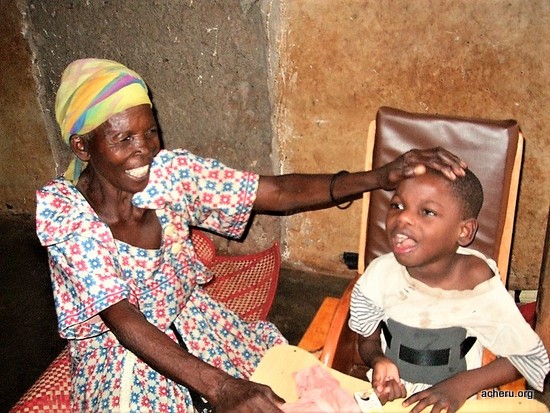 |
| Lubega (above) and Miiro (below), just two of the children for whom Acheru treatment has made such a big difference. |
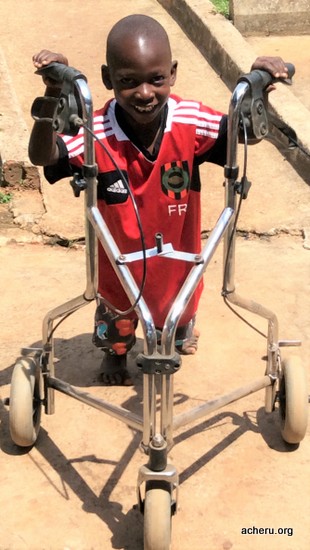 |
| 9th February 2022 Report on cerebral palsy by Bwire Timothy, Paediatric Physiotherapist, Acheru |
| Cerebral Palsy is the most common chronic disability of childhood today. It occurs as a result of brain injury to children at the age range of 0-2 years. The damage to the brain is non-progressive and can occur before, during or after birth. This results in motor defects that affect children for their life time. In addition, the children also suffer from seizure disorders, nutritional deficits, hearing impairments, vision problems, intellectual incapability, dental problems and psychological disorders. |
| The most common motor defect is spastic, it involves increase in physiological resistance of muscles to passive motion. Spastic is further sub divided into hemiplegia (affects one side of the body), Diplegia (lower limbs are more affected than upper limbs) and Quadriplegia (Total body involvement). |
| The management of CP is of a multidisciplinary approach. At ACHERU our main focus is on rehabilitation of children with CP to achieve maximum or functional independence depending on severity of the motor defects. |
| Physiotherapy is the main treatment given to the CP children however psychotherapy such as counselling and education of the condition to the mothers and care takers is also done, with follow up by the community-based rehabilitation team. In addition, appropriate referrals are done to handle vision, hearing, nutritional and dental problems. On average we attend to 45 patients per week and at least 15 patients on day. Early physiotherapy treatment as soon as diagnosis is recommended because the chance of improvement is greater as compared to when the children have grown since their physical demands increase with growth. |
| The purpose of physiotherapy treatment is to: |
| Improve the child's condition such as; training neck control, sitting, turning and ambulation thus improving their condition from non-mobility status. |
| Restoring function such as in hemiplegia we train children how to use their affected arm and lower limb to optimal or functional hand and leg use respectively. |
| Maintaining the child in the status they are in, such that the child's condition does not worsen this helps to prevent secondary problems like contractures and deformities. |
---
|
| Kyeyune Isaac is a 1 year old boy with spastic quadriplegia. At ACHERU, Isaac on examination had an asymmetrical neck, scoliosis of the spine to the left, spastic upper and lower limbs, reduced joint range of motion at joints of upper and lower limbs due to spasticity, pelvic obliquity, windswept hip deformity, bilateral equinus, flexion deformities of the fingers and thumb in palm deformity which confirmed the diagnosis of spastic quadriplegia. |
| Isaac has under gone several sessions of physiotherapy and a certain level of independence has been achieved with marked improved in neck control and increased mobility of joints, he can freely turn from side to side, a thoraco lumber sacral orthosis has been given to correct the spine scoliosis, and a CP chair to enable him to sit. His mother has been taught certain skills to assist Isaac while at home and this has contributed to inclusive participation of the family in his rehabilitation and hence improvement in his condition. |
| Currently we are focusing on training how to stabilize in sitting and in the long term provide standing frame to enable him to stand. His mother is grateful for the improvement in Isaac since the time of admission to ACHERU and she is committed to attend all his sessions of physiotherapy. |
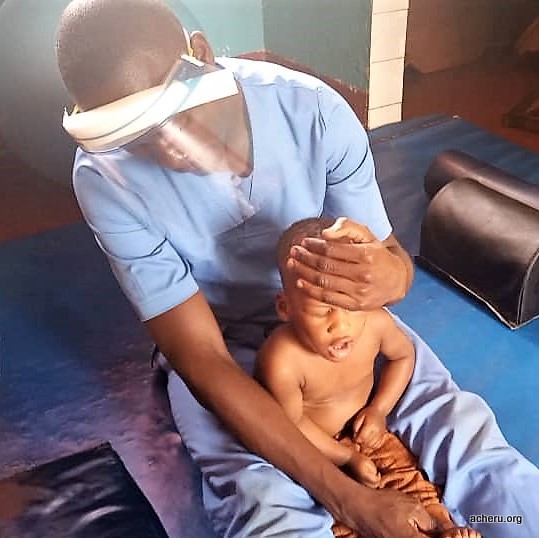 |
| Timothy working with Isaac |
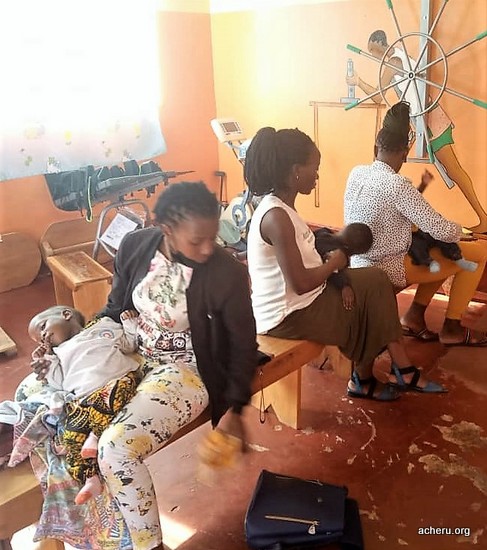 |
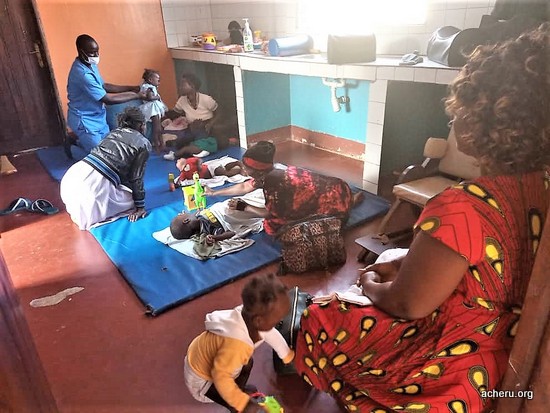 |
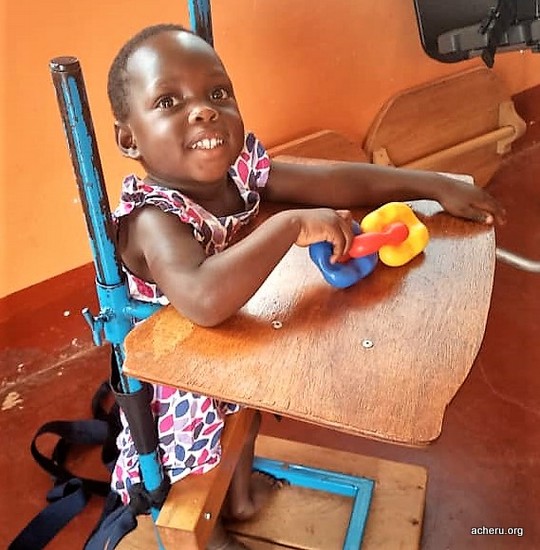 |
| Acheru CP clinic |
| Rose, our Acheru social worker, is closely involved with CP children and their families, and the following is an extract from her recent report, written 9th Feb, with details of some of the children she is working with: |
| This report details the background of children with cerebral palsy, how they are managed, and how treatment brought change in their lives and close family members. Children are affected in different ways and their treatment varies. Some undergo only physical therapy and others with spastic muscles get casts from the orthopaedic department to relax their muscles and after that they use walking aids to maintain the muscle tone. There are aids designed to assist CP children in different ways for example: |
| CP chair which helps a child who can sit on their own and helps to strengthen their muscles and get a correct sitting posture. |
| Standing frames, these are designed to train children who have difficulties with standing and strengthen their lower limbs. |
| Walking frames are designed to help children who have the ability to walk but they lack strength. |
| Wheelchairs for children who cannot help themselves to move from one place to another and they are heavy to carry, and even for those whose upper body is fine but they cannot walk. A number of children learnt different things like walking, talking, feeding themselves, sitting themselves up, toileting, dressing themselves and this is because of the treatment they have managed to receive. This benefits not only the children but also their close family members who are helping them with their day to day activities. |
| Moreen is 4 years, she was born fine but at the age of 2 she got cerebral malaria which affected her ability to sit, walk and even talk. At ACHERU physical therapy was started. She learnt how to crawl and is now starting to use a walking frame. |
| Joseph is 9 years old, he is staying with the grandmother. Joseph was so weak he couldn't do anything on his own but he has been helped by exercises and today he can walk using crutches. He is so happy to go to school like other children. |
| Jacob is 10 years old, he was born premature and became affected with cerebral palsy. Jacob is a clever boy who understands everything, before starting exercises he could not do anything on his own but today he can sit, talk and he got a chance to attend a normal school with the help of a wheel chair. |
| Vinnie is 6 years old staying with grandmother after the passing on of mother. He got cerebral malaria when still a baby and it affected most of his limbs. He could not do anything on his own but now he can sit up and is learning how to feed himself. He has good understanding and has started trying to speak some words. |
| James is 10 months old, he has cerebral palsy and club feet. Three days after birth he got cerebral malaria which affected his brain and, he became malnourished because he stopped breast feeding, but with the help of nutrition program and exercises James is improving. He is learning to sit very fast and started the treatment of correcting the feet. |
| Nakazzi is 11 years old, staying with father after the death of mother. She was born a weak child who could not anything on her own, but with the help of physical therapy is starting to walk and she can feed herself, bath herself, dress herself and talk. |
| The workshop, under Harriet's direction, has an important role at Acheru. Harriet has a lot of experience with disability aids and along with skilled part time help, a range of appliances including CP chairs, crutches, and walking frames, are produced for use at Acheru and through the Community Based Rehabilitation programme. The workshop is also used to make furnishings for Acheru, and there's the potential to provide some skills training. |
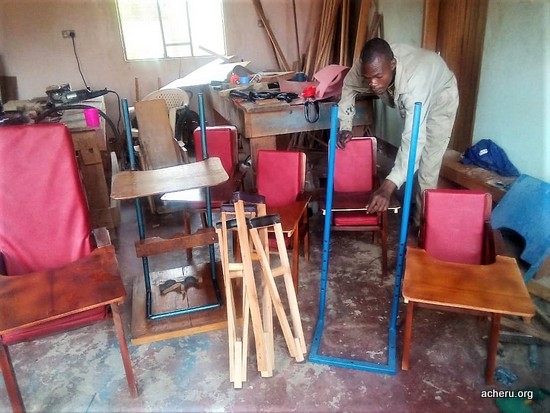 |
| Making appliances in the workshop |
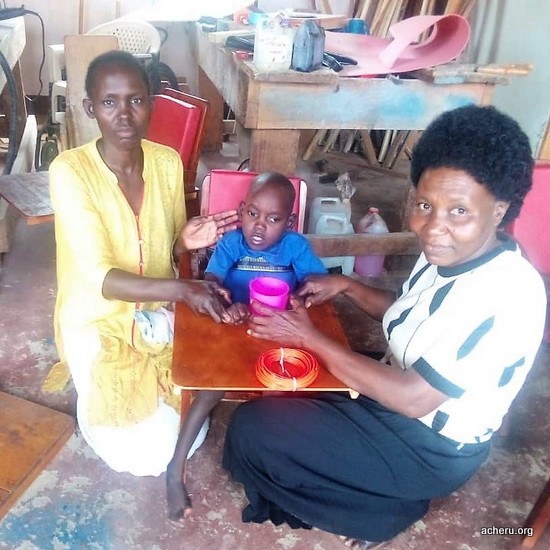 |
| Harriet preparing a CP chair |
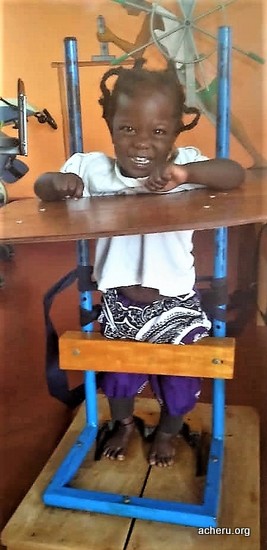 |
